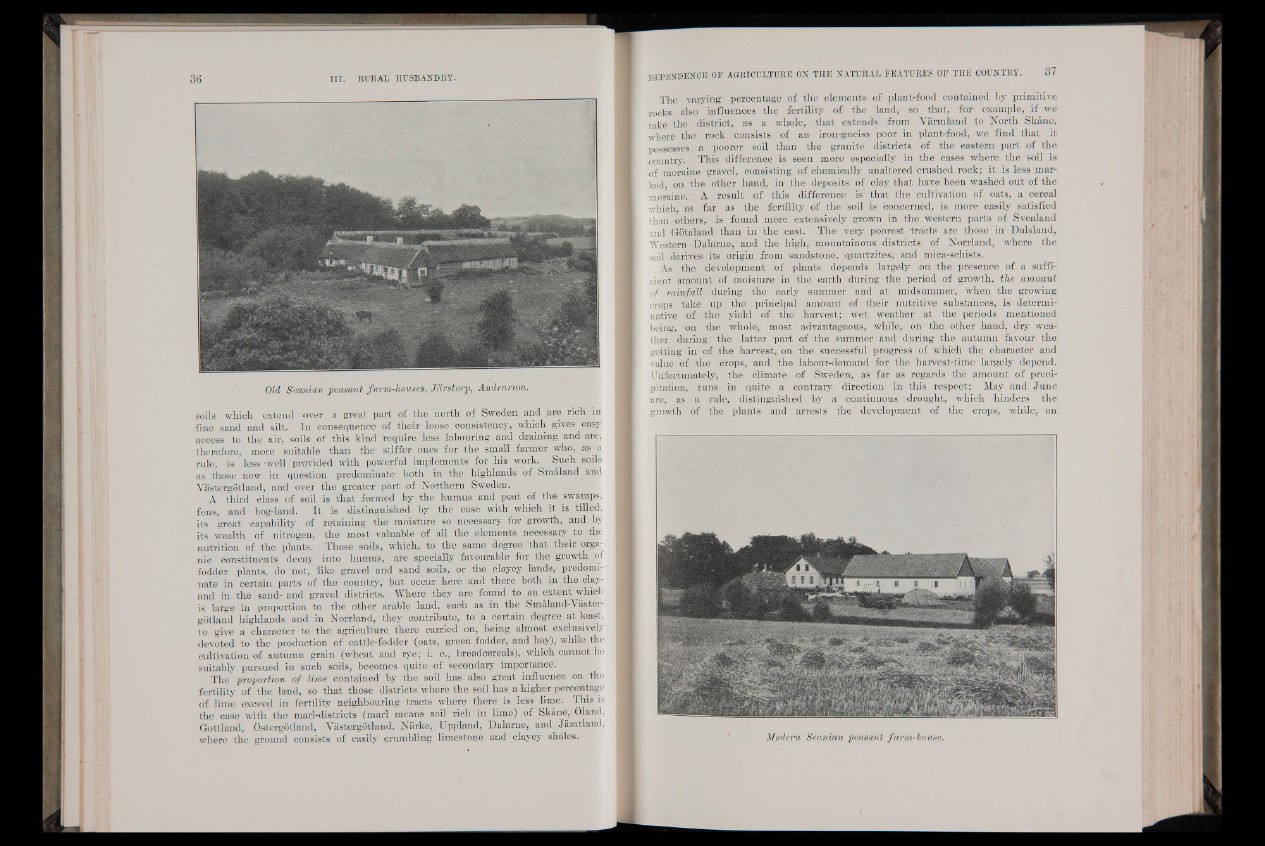
Old Scanian peasant farm-houses, Jdrstorp, Andrarum.
soils which extend over a great part, of the north of Sweden and are rich in
fine sand and silt. In consequence of "their loose consistency, which gives easy
access to the air, soils of this kind require less labouring and draining and are,
therefore, more suitable than the stiffer ones for the small farmer who, as a
rule, is less - well prbvided with powerful implements for his work. Such soils
as those now in question predominate both in the highlands of Smaland and
Vastergotland, and over the greater part of Northern Sweden.
A third class of soil is that formed by the humus and peat of the swamps,
fens, and bog-land. It is distinguished by the ease with which it is tilled,
its great capability of retaining the moisture so necessary for growth, and by
its wealth of nitrogen, the most valuable of all the elements necessary to the
nutrition of the plants. These soils, which, to the same degree that their organic
constituents decay into humus,—are specially favourable for the growth of
fodder plants, do not, like gravel and sand soils, or the clayey lands, predominate
in certain parts of the country, but occur here and there both in the clay-
and in the sand- and gravel districts. Where they are found to an extent which
is large in proportion to the other arable land, such as in the Smaland-Vaster-
gotland highlands and in Norrland, they contribute, to a certain degree at least,
to give a character to the agriculture there carried on, being almost exclusively
devoted to the production of cattle-fodder (oats, green fodder, and hay), while the
cultivation of autumn grain (wheat and rye; i. e., breadcereals), which cannot be
suitably pursued in such soils, becomes quite of secondary importance.
The proportion of lime contained by the soil has also great influence on the
fertility of the land, so that those districts where the soil has a higher percentage
of lime exceed in fertility neighbouring tracts where there is less lime. This is
the case with the marl-districts (marl means soil rich in lime) of Skane, Oland,
Gottland, Ostergotland, Vastergotland, Narke, Uppland, Dalame, and Jamtland,
where the ground consists of easily crumbling limestone and clayey shales.
The varying percentage of the elements, of plant-food contained by primitive
rocks also influences the fertility of the land, so that, for example, if we
take the district, as a whole, . that extends from Varmland to North Skane,
where the rock consists of -an iron-gneiss poor in plant-food, we find that it
possesses a poorer soil than the granite districts of the eastern part of the
country. This difference is seen more especially in the cases where the soil is
of moraine gravel, consisting of chemically unaltered crushed rock; it is less marked
on the other hand, in the deposits of clay that have been washed out of the
moraine. A result of this difference is that the cultivation of oats, a cereal
which, as far as the fertility of the soil is concerned, is more easily satisfied
than others,! is“ found more extensively grown in the western parts of Svealand
and Gotaland than in the east. The very poorest tracts are those in Dalsland,
Western Dalarne, and the high, mountainous districts of Norrland, where the
soil derives its origin from sandstone, quartzites, and mica-schists.
As the development of plants depends largely on the presence of a sufficient
amount of moisture in the earth during the period of growth, the amount
of rainfall during the early summer and at midsummer, when the growing
crops take up the principal amount of their nutritive substances, is determinative
of the yield of the harvest;- wet weather at the periods mentioned
being, on the whole, most advantageous, while; on the other hand, dry weather
during the latter part of the summer and during the autumn favour the
getting in of the harvest) on the successful progress of which the character and
value of the crops, and the labour-demand for the harvest-time largely depend.
Unfortunately, the climate of Sweden, as far as regards the amount of precipitation,
runs in quite a contrary direction in this respect; May and June
are, as a rule, distinguished by a continuous drought, which hinders the
growth of 'the plants and arrests the development of the crops, while, on
Modern Scanian peasant farm-house.